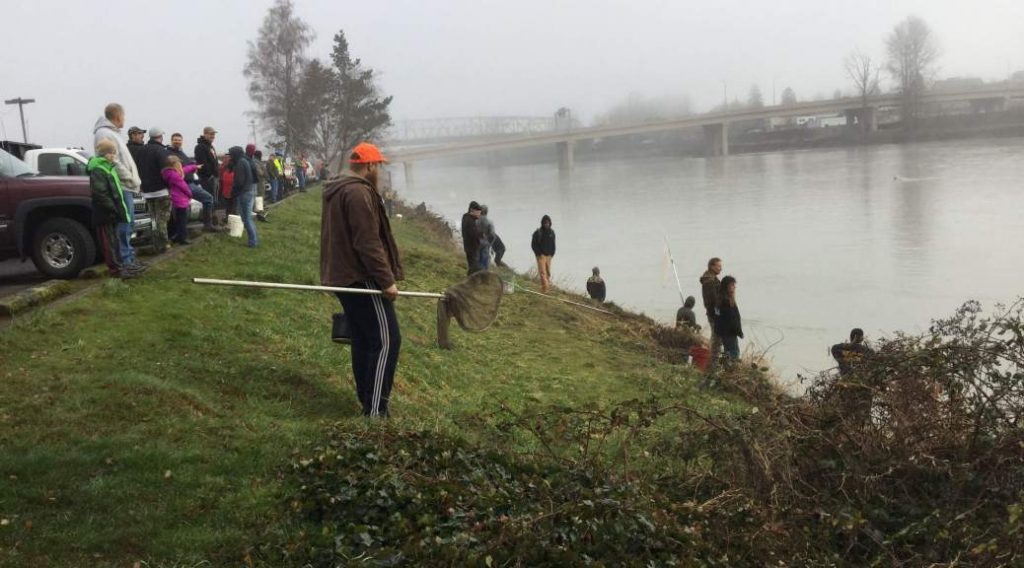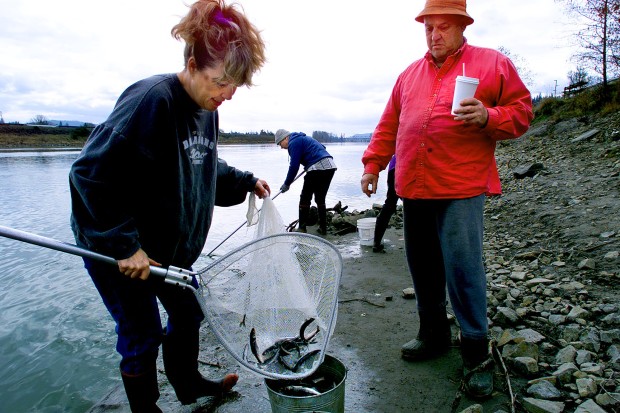First limited sport smelt dip-net fishery since 2017 is a go in the Cowlitz River this Friday with smelt present clear up to Castle Rock Leave a reply

For the first time since 2017, smelt dip-netters will get a chance to try their luck in the Cowlitz River on Friday (Feb. 14) from 8 a.m. to 1 p.m. from the Highway 432 Bridge to the Al Helenberg Memorial boat launch located approximately 1,300 feet upstream from the Highway 411/A Street Bridge in Castle Rock.
“All early indicators are that we’re seeing a pretty strong run of smelt,” said Laura Heironimus, the lead Washington Department of Fish and Wildlife (WDFW) Columbia River smelt manager. “We are taking any fisheries on a day-by-day approach.”
“So far we’ve had three days of commercial test fisheries and haven’t gotten all the tickets back for Monday’s fishery,” Heironimus said. “What I do know is that we had a delivery of 1,800 pounds (on Feb. 3) with an average of 300 pounds per delivery. And anytime we get anything over 200 pounds it is indicative of a very strong run. On Thursday (Feb. 6) we had a little over 450 pounds with an average of 100 pounds per delivery. That day we had to deal with fog and a couple fishermen weren’t able to fish in the places they normally would so that could have been a couple reasons why we saw a dip in the average pound per delivery.”
Additionally, Heironimus says they’ve seen smelt as high up as the Carnival Market in Kelso on the Cowlitz River along with some test dipping success conducted by tribal fishermen at Gearhart Park in Longview. There’s also been smelt present in the Lewis, Kalama and Carroll Slough where the Columbia meets the Cowlitz.
More Columbia River mainstem test-level gill-net commercial fisheries will continue to occur every Monday and Thursday from 7 a.m. to 5 p.m. each day through Feb. 27.

NOAA Fisheries, which oversees ESA-listed stocks, gave the green light for a limited sport dip-net harvest. Initial indicators suggest this smelt run is strong enough to offer this limited opportunity while still meeting conservation goals and help the population rebuild.
“We don’t know how big of the run will be but know that currently it is sufficient to allow the one-day recreational fishery,” Heironimus said. “We will also use (the dip-net fishery) as a route to collect biological data which helps us in the recovery of the species as well.”
The pre-season report indicates the 2020 smelt return is a low to moderate run size and expected to be similar to the 2019 return, which was an estimated 4.2-million pounds.
That 2019 smelt return estimate was the highest since 2016 and 66 percent of the 2011 to 2018 average. It also paints a much brighter picture than the 370,000 pounds in 2018 and 1.6-million pounds in 2017.
During 2014-2017, limited sport smelt fisheries occurred in the Cowlitz and Sandy rivers. In the Cowlitz it was limited to one to five days annually (five to six hours per day) and the Sandy was only open in 2014 and 2015 (two to four days annually and six hours per day). During those times sport dip-netters harvest averaged 159,060 pounds with a low of 540 pounds to a high of 290,770 pounds.
There were commercial fisheries from 2014 to 2018 consisted of eight fishing periods over four weeks on the Columbia River mainstem.
Sport dip-netting for smelt was a huge draw from the 1980s to the early 2000s when thousands of people dressed in waders and dip-nets would line the Cowlitz River shoreline.
Smelt returns have steadily declined to the point where they were listed on the Endangered Species Act in the spring of 2010. Commercial and recreational fisheries were subsequently closed in 2011-2013.
There was one day of sport dip-netting in 2017 when 1.6-million pounds returned; and one day in 2016 when 5.1-million pounds returned along with opportunities both years on the Sandy River in Oregon.
There were also fishing seasons – five days total in 2014 and two days in 2015 –plus opportunities on the Sandy River.
Smelt abundance increased steadily from 2011 to 2014 when it peaked at 16.6-million pounds in 2014.
Ocean environmental conditions were favorable for marine survival during 2012-2013 but then deteriorated dramatically although improvement was seen the past few years.
Each dip-netter may retain 10 pounds of smelt daily with no more than one day’s limit in possession. Ten pounds is about a quarter of a 5-gallon bucket. No fishing license is required to dip net for smelt in this limited fishery.
“We’ve also had flooding on the Cowlitz but it is already subsiding although river levels and flows may still be very strong,” Heironimus said. “Public safety is a main concern and we’d like people to use caution if they’re planning on going. “We’ll have WDFW staff counting from shore and by boat, and also plan to have enforcement officers present to help ensure the safety and making sure people are following the rules.”

